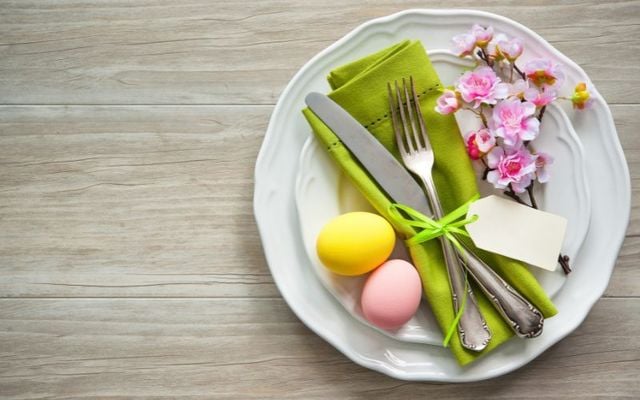Get ready for an Easter Sunday feast with these tasty Irish recipes for the special day!
Get ready for the end of Lent with these delicious Irish recipes for Easter, courtesy of the folks at IrishCultureAndCustoms.com!
As they explain, in old Ireland, Easter Sunday was a day of great celebration, not the least of which was the blessed relief from the abstinence of meat for nearly two months. Here, you can take your pick of lamb or ham.
Below are the recipes for the meat dishes is a perfect vegetable accompaniment to any spring-time dinner menu.
And for "afters" – the Irish term for dessert - their resident Irish recipe collectors and contributors offer a delightful suggestion.
Irish Easter recipe: Garlic-ginger Roast Leg of Lamb
Preparation Time: 35 minutes
Roasting Time: 1 hour 30 minutes
Cooking Tip: The crust mixture can be made and spread on the lamb up to 1 day ahead. Cover loosely with foil and refrigerate.
Ingredients:
- 8-pound bone-in leg of lamb, trimmed of excess fat
- 1 tablespoon olive oil
- 1 tablespoon chopped fresh mint (optional)
- 1/2 teaspoon each salt and pepper
- 2 teaspoons each of minced garlic and fresh ginger
- 2 tablespoons all-purpose flour
- 1 cup beef broth
- 2 teaspoons lemon juice
- 1/8 teaspoon pepper
Method:
Heat oven to 450°F. Have a large roasting pan with a rack ready. Place lamb on rack.
Mix oil, mint, garlic, ginger, salt, and pepper in a small bowl. Add flour and stir until blended. Spread over top and sides of the lamb.
Roast 30 minutes, and then reduce temperature to 325 degrees F. and roast 45 to 60 minutes longer until done as desired. (Rare: 130 F. on a meat thermometer inserted in thickest part not touching fat or bone; 140°F for medium and 150°F. for medium-well).
Remove to a serving platter, cover loosely with foil to keep warm and let stand 15 minutes. (As the meat rests, juices redistribute and internal temperatures should rise about 10 degrees).
Meanwhile, spoon off and discard fat from the roasting pan. Place pan over high heat, (see note below is using a disposable foil pan), add beef broth and bring to a boil, scraping up browned bits from the bottom of the pan. Boil 2 minutes to reduce liquid slightly. Pour into a sauceboat and stir in lemon juice and pepper, This will make 2/3 cup to drizzle over sliced lamb. Serves 12 with leftovers.
Note: If using a foil roasting pan, bring the broth to a boil in a saucepan, pour into foil pan (do not place on the burner) and stir to scrape up brown bits on the bottom. Pour broth back into saucepan and boil and season as directed above.
Irish Easter recipe: Glazed Ham with Horseradish Mustard Sauce
Serves 12 with leftovers
Preparation Time: 22 minutes
Baking Time: 2 Hours
Cooking Tip: The sauce and the Glace can be made up to 3 days ahead and refrigerated.
Ingredients:
- 7-pound shank or rump-end, fully cooked bone-in smoked ham.
Glaze:
- 2/3 cup light brown sugar
- 1/4 cup honey
- 1/4 teaspoon ground cloves
Sauce:
- 1/2 cup mayonnaise
- 1/2 cup reduced-fat sour cream
- 3 tablespoons Dijon mustard
- 2 tablespoons snipped chives or green part of scallions
- 1 teaspoon prepared white horseradish
- 1/2 teaspoon pepper
Method:
Heat oven to 325°F. Line a shallow roasting pan rack with foil. Set a sturdy, flat metal rack in pan.
Cut rind off the ham and trim off excess fat, if any. Place ham on a rack. Cover loosely with foil and bake 1 1/4 hours.
Meanwhile, whisk Glaze ingredients in one small bowl and Sauce ingredients in another small bowl until blended.
Remove foil from ham and spread evenly with Glaze. Bake uncovered 40 to 45 minutes or until a meat thermometer inserted in the thickest part (not touching the bone) registers 140°F. Let ham rest 15 minutes before slicing. Serve with the sauce.
Irish Easter recipe: Glazed Asparagus & Carrots with Pecans
A lemon glaze tops a springtime combination of fresh asparagus and carrots.
Yield: 6 servings
Ingredients:
- 1 cup of water
- 3 large (2 cups) carrots, sliced diagonally 1/4-inch
- 1 pound fresh asparagus, trimmed
- 1/4 cup butter
- 1 teaspoon cornstarch
- 3 tablespoons water
- 1 tablespoon lemon juice
- 1 teaspoon grated lemon peel
- 2 tablespoons chopped pecans, toasted
Method:
Place 1 cup water in 10-inch skillet over medium heat. Bring to a full boil; add carrots and asparagus. Cover; continue cooking, stirring occasionally, until carrots and asparagus are crisply tender (7 to 9 minutes). Drain. Set aside; keep warm.
Melt butter in the same skillet. Stir together cornstarch, 3 tablespoons water and lemon juice in small bowl; stir into butter. Cook over medium heat, stirring constantly until sauce thickens (2 to 3 minutes). Stir in lemon peel.
To serve, spoon sauce over warm carrots and asparagus. Sprinkle with pecans.
Irish Easter recipe: Easter Basket Cake
Makes 12 servings
Ingredients:
Cake:
- 1 cup butter, softened
- 1 cups granulated sugar
- 4 eggs
- 2 tablespoons vanilla extract
- 2 3/4 cups all-purpose flour
- 2 teaspoons baking powder
- 1/2 teaspoon baking soda
- 1 1/2 cups buttermilk
Butter Icing:
- 1 cup softened butter
- 5 cups icing sugar alternately with 1/3 cup of milk
- 2 tablespoons of vanilla extract
Fluffy Icing:
- 1 cup white corn syrup
- 2 egg whites
- 1/2 teaspoon cream of tartar
- 1 teaspoon vanilla
Method:
Grease sides of three 9-inch round cake pans; line bottoms with parchment or waxed paper. Set aside.
In a large bowl, beat the butter with the sugar until fluffy. Beat in eggs one at a time, beating well after each. Beat in vanilla extract.
Combine flour, baking powder, and bakig soda. Stir into butter mixture alternately with the buttermilk, making 3 additions of the flour mixture and 2 additions of buttermilk.
Divide among the three prepared cake pans, smoothing the tops. Bake in the center of the oven at 350 degrees F. (180 C) oven for 30 minutes or until a cake tester comes out clean. Let cool in the pans on a wire rack for 15 minutes.
Run a knife around edges and turn the cake out onto the rack and peel off the paper. Turn right side up, let cool on racks. While cakes are cooling, mix up the frostings.
Butter Icing:
This easy all-purpose icing covers the cake with delicious flavors. In a bowl, beat 1 cup softened butter till fluffy; then beat in 5 cups icing sugar alternately with 1/3 cup of milk; making 3 additions of sugar and 2 of milk. Then beat in 2 tablespoons of vanilla extract.
Fluffy Icing:
This light-textured, not-too-sweet icing is ideal for matching feather-light angel food cake. It works well on cupcakes as well. Freeze any leftovers in an air-tight container for up to 2 weeks.
In a saucepan, bring corn syrup to boil over high heat. Meanwhile, in a bowl set over simmering water, beat egg whites with cream of tartar until frothy. Beat in corn syrup in a thin steady stream; beat for about 4 minutes or until stiff peaks form. Remove from heat; beat in vanilla.
Cake Assembly:
For the basket handle, we painted one we removed from an inexpensive Easter basket.
Spread butter icing on top of two cake layers. Place 1 of the layers on a flat serving plate and stack the remaining layers on top. Refrigerate for 1 hour or until icing is firm.
Remove 1 cup of fluffy icing, set aside.
Spread remaining icing over top and sides of the cake. While the icing is still soft, make a "basket weave" on the sides of the cake. Pull a skewer vertically from the bottom to the top at æ-inch intervals. Pull the skewer horizontally at æ-inch intervals from 1 line to the next, stopping at each line and lifting at end of the stroke.
Using a piping bag fitted with a plain tip, pipe the reserved icing into beads around the top and bottom edges.
Decorate with cookies (if you wish) propping them up with small marshmallows. Or "fill the top of the basket" with assorted Easter candies.
Variation: One year we made Easter "grass" with shredded coconut and placed it on top of the basket cake and then placed colored eggs on top of it. Combine 3 drops of green food coloring with a teaspoon of water. Stir it into 1 1/2 cups of sweetened coconut flakes until evenly tinted, but you must use it immediately.
* Originally published in August 2016. Last updated in April 2025.




Comments